21.5-inch iMac (Late 2013) Review: Iris Pro Driving an Accurate Display
by Anand Lal Shimpi on October 7, 2013 3:28 AM ESTGPU Performance: Iris Pro in the Wild
The new iMac is pretty good, but what drew me to the system was it’s among the first implementations of Intel’s Iris Pro 5200 graphics in a shipping system. There are some pretty big differences between what ships in the entry-level iMac and what we tested earlier this year however.
We benchmarked a Core i7-4950HQ, a 2.4GHz 47W quad-core part with a 3.6GHz max turbo and 6MB of L3 cache (in addition to the 128MB eDRAM L4). The new entry-level 21.5-inch iMac is offered with no CPU options in its $1299 configuration: a Core i5-4570R. This is a 65W part clocked at 2.7GHz but with a 3GHz max turbo and only 4MB of L3 cache (still 128MB of eDRAM). The 4570R also features a lower max GPU turbo clock of 1.15GHz vs. 1.30GHz for the 4950HQ. In other words, you should expect lower performance across the board from the iMac compared to what we reviewed over the summer. At launch Apple provided a fairly old version of Iris Pro drivers for Boot Camp, I updated to the latest available driver revision before running any of these tests under Windows.
Iris Pro 5200’s performance is still amazingly potent for what it is. With Broadwell I’m expecting to see another healthy increase in performance, and hopefully we’ll see Intel continue down this path with future generations as well. I do have concerns about the area efficiency of Intel’s Gen7 graphics. I’m not one to normally care about performance per mm^2, but in Intel’s case it’s a concern given how stingy the company tends to be with die area.
The comparison of note is the GT 750M, as that's likely closest in performance to the GT 640M that shipped in last year's entry-level iMac. With a few exceptions, the Iris Pro 5200 in the new iMac appears to be performance competitive with the 750M. Where it falls short however, it does by a fairly large margin. We noticed this back in our Iris Pro review, but Intel needs some serious driver optimization if it's going to compete with NVIDIA's performance even in the mainstream mobile segment. Low resolution performance in Metro is great, but crank up the resolution/detail settings and the 750M pulls far ahead of Iris Pro. The same is true for Sleeping Dogs, but the penalty here appears to come with AA enabled at our higher quality settings. There's a hefty advantage across the board in Bioshock Infinite as well. If you look at Tomb Raider or Sleeping Dogs (without AA) however, Iris Pro is hot on the heels of the 750M. I suspect the 750M configuration in the new iMacs is likely even faster as it uses GDDR5 memory instead of DDR3.
It's clear to me that the Haswell SKU Apple chose for the entry-level iMac is, understandably, optimized for cost and not max performance. I would've liked to have seen an option with a high-end R-series SKU, although I understand I'm in the minority there.
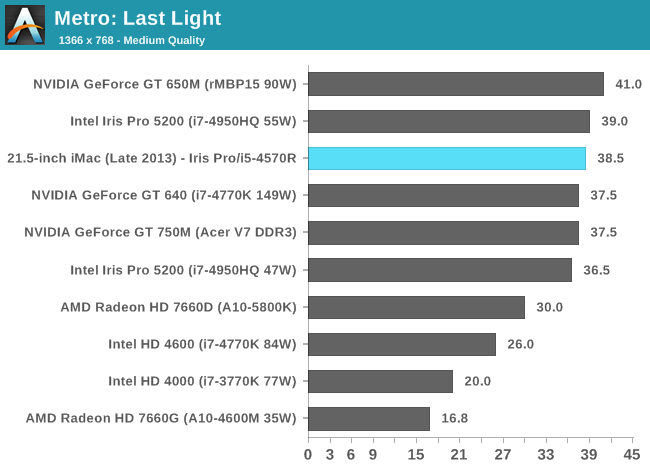
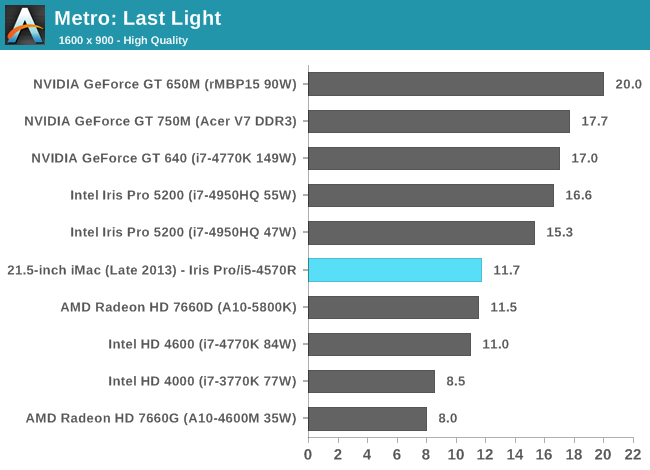
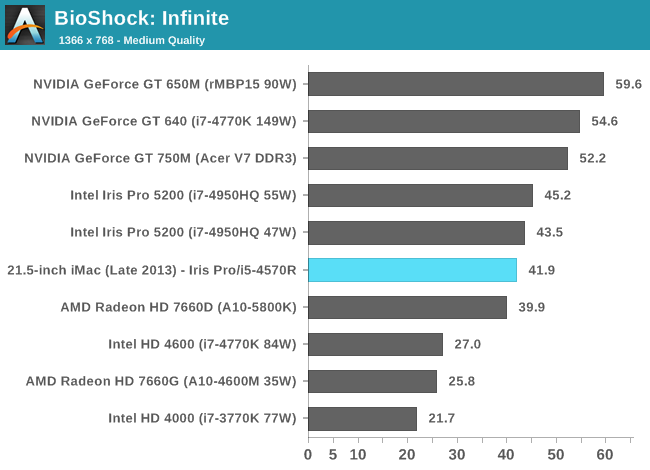
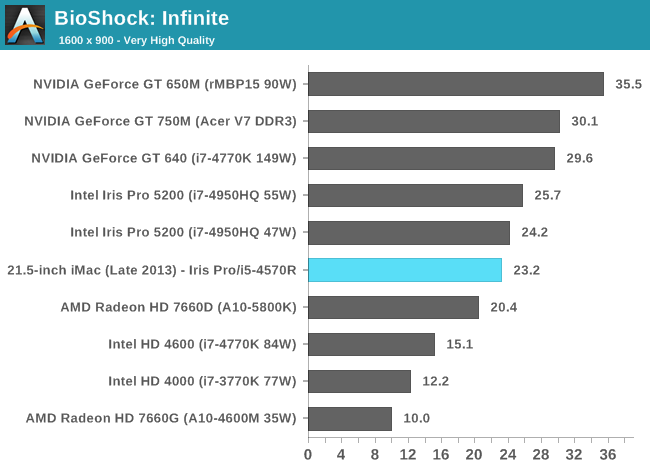
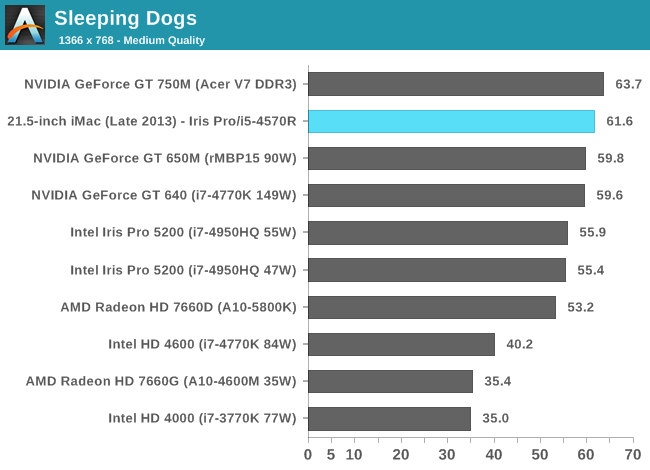
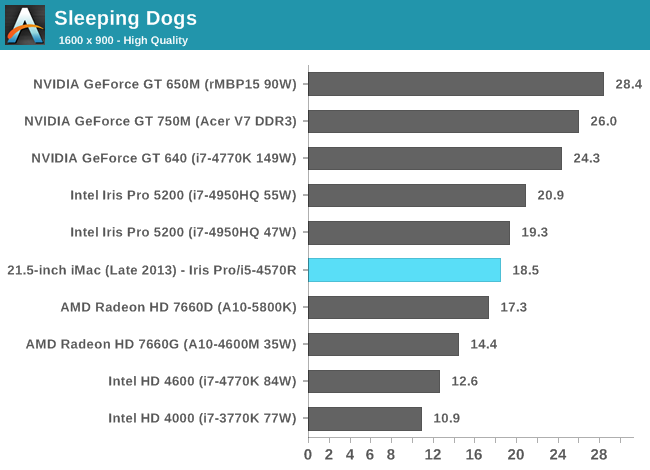

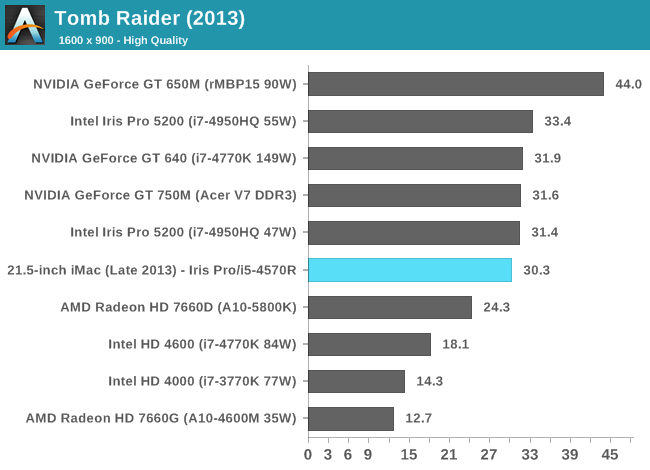
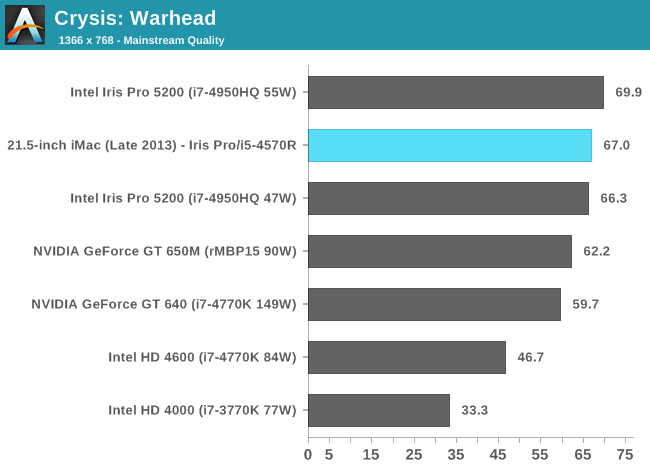
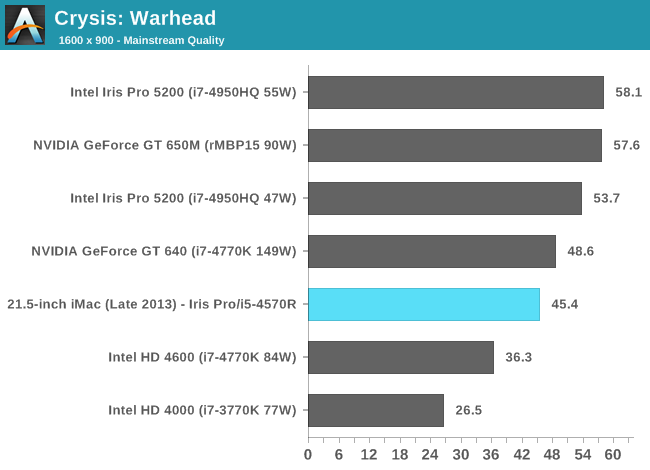
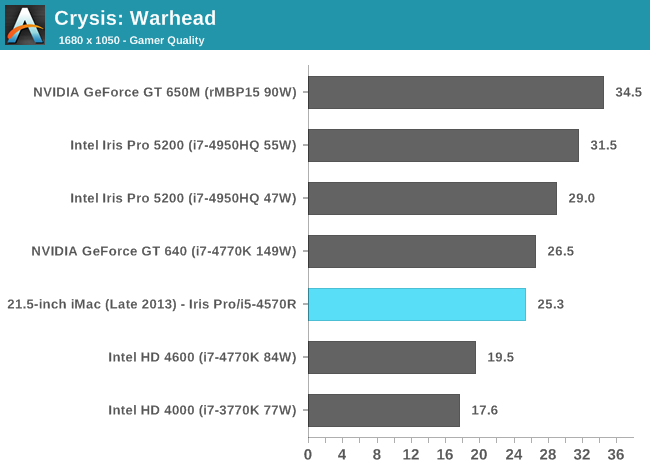
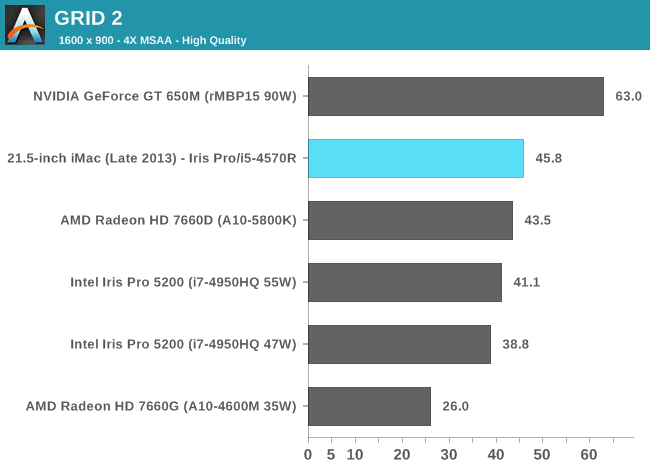
These charts put the Iris Pro’s performance in perspective compared to other dGPUs of note as well as the 15-inch rMBP, but what does that mean for actual playability? I plotted frame rate over time while playing through Borderlands 2 under OS X at 1080p with all quality settings (aside from AA/AF) at their highest. The overall experience running at the iMac’s native resolution was very good:
With the exception of one dip into single digit frame rates (unclear if that was due to some background HDD activity or not), I could play consistently above 30 fps.
Using BioShock Infinite I actually had the ability to run some OS X vs. Windows 8 gaming performance numbers:
| OS X 10.8.5 vs. Windows Gaming Performance - Bioshock Infinite | ||||
| 1366 x 768 Normal Quality | 1600 x 900 High Quality | |||
| OS X 10.8.5 | 29.5 fps | 23.8 fps | ||
| Windows 8 | 41.9 fps | 23.2 fps | ||
Unsurprisingly, when we’re not completely GPU bound there’s actually a pretty large performance difference between OS X and Windows gaming performance. I’ve heard some developers complain about this in the past, partly blaming it on a lack of lower level API access as OS X doesn’t support DirectX and must use OpenGL instead. In our mostly GPU bound test however, performance is identical between OS X and Windows - at least in BioShock Infinite.


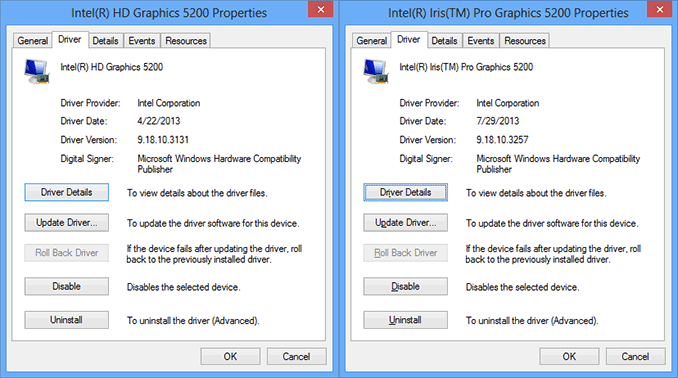
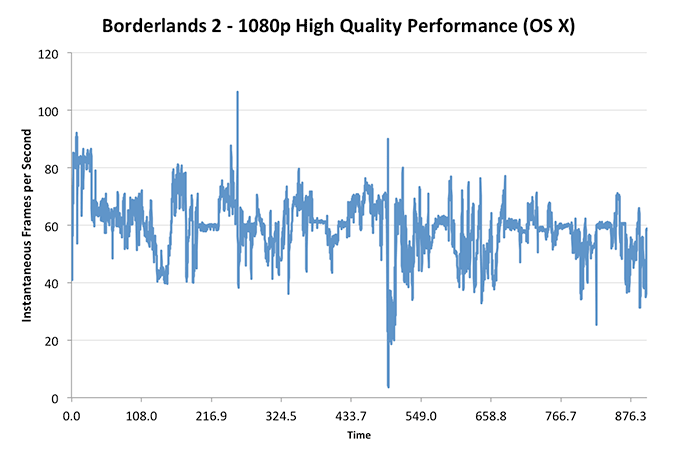








127 Comments
View All Comments
mschira - Tuesday, October 8, 2013 - link
Could one buy a super fast USB3 SSD and build ones' own fusion drive on the cheap?Cheers
M.
name99 - Wednesday, October 9, 2013 - link
Yes --- if you're willing to be daring.Essentially you'd need to boot off a third drive (or the network) then use diskutil cs commands to create an LVG then an LV tying the two drives together. There are instructions on the web giving details.
On a different point, I don't think Anand is correct in saying that Fusion works better than other hybrid solutions because it tracks blocks. I think the real answer is that it does a MUCH smarter job of tracking file "temperature". OSX has, since about 10.3, tracked file temperature (which is essentially a combination of how large the file is and how often it's accessed). This was done back then (and is still done) to move the hottest files to a small "hot files" area at the start of a disk for the obvious performance reasons.
Details here:
http://osxbook.com/book/bonus/misc/optimizations/#...
My guess is that Fusion essentially hooks into this mechanism, and just redefines the constants controlling how large the hot file area is to have it cover all of the SSD (minus of course the area for file system metadata, the area that is reserved for fast writes, and so on).
I can't think of any realistic situation (within pure OSX) where tracking by blocks rather than files is useful, and it would require a whole new way of looking at the problem. I think the obvious way to test this would be to look at the behavior of VM images which, assume, as a whole don't count as hot because they are very large, but which do have hot blocks inside them. If you look at IO when, say, starting up a VM, do you see all the IO coming from the HD, or do you see it all come from the SSD, with HD accesses coming later once the VM is booted and we're now pulling in less frequently accessed blocks?
Risas - Thursday, October 10, 2013 - link
What a silly review and comparison. Apple vs Apple, conclusión: the Moore's law still works.CPU performance: It look like Apple made any work instead of changing the Intel CPU, Apple CPU performance comparison? there's no other comparison of the Intel's CPUs? Just look at them, what to spect?
And over and over... Apple iMAc vs Apple iMacs, who wins? Apple, of course.
Final words..."Apple continues to have the strongest Mac lineup of its history" Does any other have MAC lineups? Of course no, as it's a monopolistic stuff. So It's unnecesary to say what's obvious.
Apple's Haswell?? yo write the article as if Apple did anything on the Haswell desing or manufacture.... Maybe Intel have to say something about it...
And here is what really matters: The iMac’s industrial design is beautiful.
No complains about the small breaking-wrist keyboard or any thing as Apple fights againts Apple it wold be always a winner: Apple.
Commodus - Thursday, October 17, 2013 - link
I'd say the Apple vs. Apple comparisons are valid because of the limited all-in-one market. It's hard to find something comparable; a lot of iMac alternatives are either budget models or use significantly different components (see the ASUS Transformer AIO or Lenovo IdeaCentre A730 as examples). The company practically dominates the category, at least in North America and Europe.Haplodepatrijn - Thursday, October 10, 2013 - link
Doses this mean we can finally use the GPU render in Blender ?shweetuant - Friday, October 25, 2013 - link
HiIf I am planning to install Windows 7 64-bit as virtual running side by side with OS X. Is the default 8GB of ram sufficient?
kkirk - Tuesday, December 3, 2013 - link
I was wondering if there will be a late 2013 Macbook Pro 15" review coming soon?